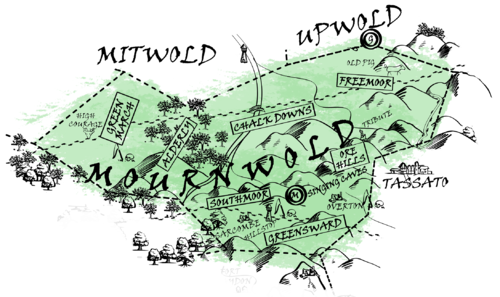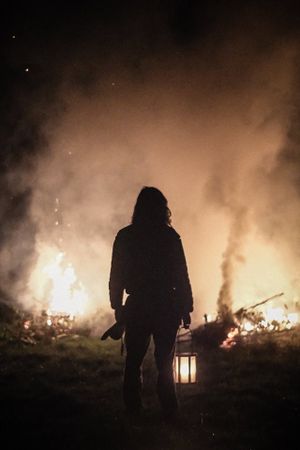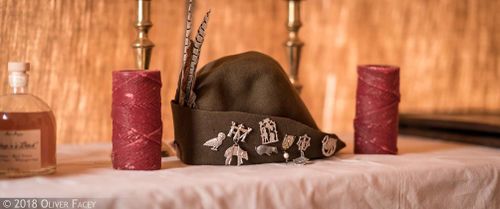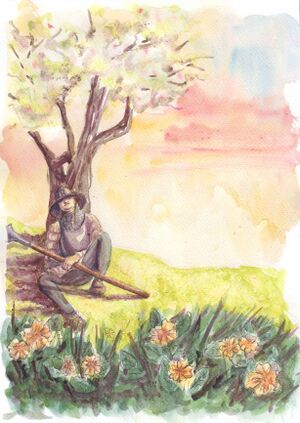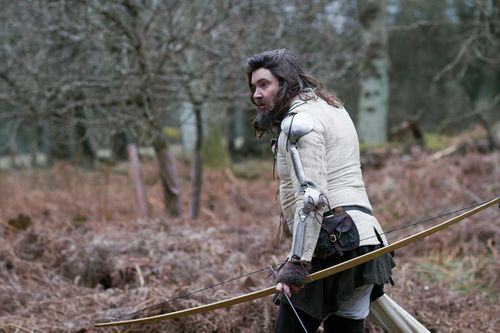Mournwold
The Mourn
This desolate land was known as the Mourn long before it fell to the barbarian Jotun in 349YE. The name originally referred to the sound of the wind in the trees and across the craggy hills. Now it seems an even more fitting name; the Mournwold has become synonymous with loss and sorrow for many Marchers.
Whereas Upwold and Mitwold in particular are known for their sprawling farms, the rugged Mournwold is better known for its mines. The hills are riddled with rich veins of green iron, and with mine workings dedicated to extracting that ore. Prior to the invasion of the Jotun, there had been a growing tide of dissatisfaction among professional miners that all political power was vested in the hands of those who owned farms. There were regular complaints that mine owners, like farmers and stewards, owned and worked land - the only difference was that the crops they raised were ore and stone rather than fruit, grain or vegetables. Some of this dissatisfaction had its roots in the sharp business practices by some of the lowland stewards, especially those of the Chalkdowns, who set high prices for the food sold to the miners.
Recent History
Nearly forty years ago, the Mournwold fell to the Jotun orcs. The barbarian forces that eventually defeated the Marchers amassed for months in Liathaven. Imperial forces fought long and hard, but they were outnumbered and outmatched. The Marcher generals of the time blamed The Throne, Emperor Hugh, for the loss, claiming that they had supported the Dawnish emperor specifically to prevent this kind of disastrous military defeat. When the Mourn fell, its last Senator, Thomas Overton, entered the wicker man in an attempt to heal the breach between Marches and Empire. Despite his sacrifice, the resentment of the Marchers simmered for much of the next three decades as the generals became more focused on the recovery of the Mourn. Thomas' sacrifice was later echoed by that of Nedry Galest, General of the Tusks, who chose to enter the wicker man after the disastrous events of Spring 381YE.
After the dust settled, only the Greensward remained in Imperial hands. A portion of the population of the Mournwold fled when the territory fell. Most took refuge in the north, but a number of miners and hill folk from the south found sanctuary in Tassato to the east, eventually being subsumed into the League. Those who remained were given the Jotun choice - take up arms and fight for the orcs as Jotun, or lay down their weapons and become thralls. The majority of Marchers who refused to flee chose to become thralls, working their farms and providing food to their barbarian overlords. The situation changed little over the next thirty years; a few border skirmishes but no serious invasion attempt. Even Empress Britta made no immediate move to liberate the Mournwold; the first Imperial attempt to drive the Jotun out and reconquer the territory would not take place until after her death, and the collapse of the temporary Jotun ceasefire of 377YE - 379YE.
The liberation began after the Autumn Equinox 379YE. The Tusks and the Bounders were joined by both Imperial Orc armies and the Highborn of the Seventh Wave at Overton. The initial attack saw the liberation of Ore Hills, and parts of Freemoor, but also exposed the Empire for the first time to the knowledge that the Jotun had human soldiers fighting alongside them - mostly young folk who had grown up under the occupation.
The Imperial advance quickly faltered in the face of the rage of the Jotun. Angered by the broken treaty between themselves and the Empire, the Jotun reinforced their positions in the Mournwold and brought the Empire's armies to a standstill. Three thousand Imperial soldiers died, and perhaps twice that many Jotun - a bloody cost that would set the stage for the bloodshed to follow. The Jotun counterattack drove the Empire back out of Ore Hills and Freemoor - leaving the partially completed fortification there to be claimed by the orcs. The Tribute was quickly claimed by the Jotun, and became a key part of their defence of the territory inthe coming months. Indeed, the force of the Jotun push was sufficient to drive the Imperial forces back to Overton, nearly costing them the Greenward. By the start of the Autumn Equinox 380YE, the Jotun had taken Overton as well, claiming complete uncontested control of the Mournwold for the first time. Their victory was short-lived - Imperial heroes managed to recapture Orchard's Watch and Overton during the Autumn Equinox, but at great cost.
After the Winter Solstice 380YE, the Greensward in southern Mourn was the site of some of the most terrible battles in recent Imperial history, when the Imperial host laid a trap for the Jotun armies. With powerful magical support, an immense number of humans and orcs lost their lives and most of the structures in the Greensward were levelled including the town of Overton and the castle of Orchard's Watch. At the same time, Spring plague and Winter magic accounted for perhaps a sixth of the remaining population, and half the people still living in the Greensward. The Jotun and the people of the Mourn alike were unprepared for the ferocity of the Imperial assault.
The repercussions of these battles cannot be understated. The Jotun morale was broken, but so was that of the people of the Mourn. The Summer solstice saw the Empire make significant gains in the Mournwold, but for all that they were gaining territory, they had lost the support of the people who lived there. The Jotun retreated west into Liathaven, leaving token forces to defend the Tribute and the castle at Hillstop. They evacuated as many thralls - humans as well as orcs - as they could, but they put up little opposition to the Imperial troops. Indeed during the Autumn Equinox 381YE, the Jotun destroyed Hillstop rather than allow it to fall into Imperial hands.
While the Mournwold was officially Imperial again by the start of the Autumn Equinox 381YE, the people of the Mournwold - including for the time being a great many orc thralls - were not shy about expressing their unhappiness to the rest of the Empire.
Points of Interest
Sarcombe
A market town in Southmoor, Sarcombe has been largely rebuilt since its recent near-destruction during the liberation of the Mourn. The sprawling Old Oak Inn is the oldest building in the town and has stood for two centuries, built up around the trunk of an actual oak tree. During the Jotun occupation, it was a centre of orc power and they ultimately constructed a fortification there - Hillstop - which obviously is no longer standing. After the Jotun were ejected, Empress Lisabetta declared that "The town of Sarcombe in Southmoor has a long history as a centre of rich commerce" and secured it a charter as a market town - the first in some time.
Although it was only recently granted their charter by the Empire, the market town is already booming, with individuals from all over the Mourn moving to the area looking to make a place for themselves. There is a shortage of houses, but no shortage of work to be done, with signs in many shop windows offering opportunities for those prepared to work hard. The Senate elected not to extend the Blood Red Roads to Sarcombe, but they did commission the construction of a large new metal market here, overseen by the Imperial title of Master of Sarcombe Metal Market. The Sarcombe Register, based out of the Jarl's Head tavern, provides a secure place to keep records of births and deaths throughout the territory. The Bounders Hall serves as a location where groups of beaters can work with the thralls to keep farms free from thieves and outlaws. These commissions, and more, contribute to the sense that Sarcombe is a town with a future, a place where honest Marchers can prosper together, a settlement with unrealised potential.
Farstrider's Watch
Completed shortly before the Winter Solstice 382YE, Farstrider's Watch was funded by Imperatrix Lisabetta. It was one of the first fortifications completed with the aid of the virtuous, in the wake of the consecration of the Silent Sentinel in Casinea. The castle was partially built in answer to calls from the citizens of the Mournwold to ensure they were protected from Jotun retaliation.
Standing sentinel on the Greensward, Farstrider's Watch was named for the beloved Marcher general Alusair Farstrider of House Balston, who fell in battle against the western orcs alongside many of her household. While she and her fellow soldiers were Upwolders, they are seen by many as having died fighting for the freedom of the people of the Mournwold. The castle has since become an unofficial place of pilgrimage for some Marchers, beginning with members of House Balston but spreading slowly to other parts of the Marches. General Farstrider and the "Badger's Boys" - the brave yeofolk of House Balston who fell alongside her - are seen in some places as inspirational figures whose loyalty, courage, and pride in their nation are inspirational. The Imperial Synod has not commented on this practice so far, although as neither the general nor any of her fellow yeofolk have been recognised as paragons or exemplars, these pilgrims must be careful not to open themselves to accusations of blasphemy
Landskeeper's Bulwark
The fortification of Landskeeper's Bulwark in Freemoor was built as a physical symbol of the Empire's dedication to the protection of the people of the Mournwold. It was commissioned by the Imperial Senate to address the concerns of the people in the wake of the liberation of the Mourn. The small castle takes its name from the Landskeepers, those who help keep Marcher traditions alive; it is designed as a place of refuge with ample room set aside for the tending of the sick. The name is also a subtle nod to the desire to reincorporate the dispossessed of the Mourn back into Marcher culture. At the heart of the keep is a small orchard surrounded by a compact but well-crafted garden, which serves as both a place of contemplation and a memorial to those who died driving the Jotun out of the Mournwold.
The Singing Caves
The Singing Caves are a Bourse resource located on the Greensward near Overton. Custodianship of the Caves is an Imperial Title that brings with it a Seat on the Imperial Bourse. It produces 28 Imperial wains of mithril every season.
Orchard of the Watch
The Orchard of the Watch is a memorial constructed among the ruins of Overton. Built to bring peace to the restless spirits that haunt the land and those who survived its bloody liberation. It stands within the ruins and incorporates the Jotun burial mounds just north of them. These mounds bear both Jotun and Imperial dead and have been planted with apple trees. Many new trees have been planted, using the available space, and lacking typical row or grid order to avoid interfering with the remaining structures.
Myriad artists, artisans and labourers, motivated by the call of Friar John of the Mourn and the Pride assembly, aided in the memorial's construction. The walls are covered with murals, engravings, and hangings depicting moments of heroic defence or scenes of peaceful life in old Overton. Remnant paths and masonry have been enriched with wildflowers and tasteful greenery.
The Friar of Honour's Rest supports those who tend to the orchard and the spirits who remain in the area.
Along a length of Orchard’s Watch’s enduring wall are engravings of the names of those believed to have died over the course of the liberation. Above all the names is a plaque with the words of Simon Chordwangler Willow who proposed the motion.
May this Orchard Keep and Watch
Over those we have lost,
Those that were taken from us
And those who remain.
The ruins of Overton
Once a sheep-farming town and market set on a hill, Overton was ruined early on in the great Battle for the Greensward. The majority of the defenders were killed refusing to leave their posts. Pilgrims visit the ruins of Overton to lay tokens at the graves of the fallen. North of the ruins, the Jotun raised a massive grass-covered burial mound, beneath which lie both the bodies of countless Imperial soldiers and the Jotun who fell fighting them. Apple trees grow at the crest - it is not clear whether the orcs planted them in deference to Marcher burial customs, or whether they are the work of the surviving monks of Greensward Abbey. When the Empire liberated Greensward shortly before the Autumn Equinox 381YE there was some talk of disinterring the mound, but the Marcher soldiers were adamant they be left to rest undisturbed - the soil may have been soured, but it is still the soil they died fighting for, whether they were Marchers or not.
Not far from the ruins stands Honour's Rest, a small shrine and orchard tended by friars who watch over the ruins and the barrow mounds.
Ruins of Orchard's Watch
Commissioned by the Imperial Senate in Autumn 378YE, the fortification of Overton largely took place during the Jotun ceasefire. Work was overseen by Bridget Eastville, senator for Mitwold, and took place under the watchful gaze of Jotun scouts. The fortification consisted of solid walls around most of the town, with a central keep. A number of buildings damaged by Jotun raids were cleared, and apple trees planted in their place - a memorial to those Marchers who had died fighting for the Empire. The keep incorporated the old fortified manor house that served as a stop-gap defence - a base of operation for scouts gathering information about Jotun activity in the territory.
During the great Jotun offensive after the Winter Solstice 380YE, following several seasons of concerted attacks, the castle was levelled by orc siege engines. The memorial apple orchard burned during the fall of Overton - it is not known which side set the fire that consumed it.
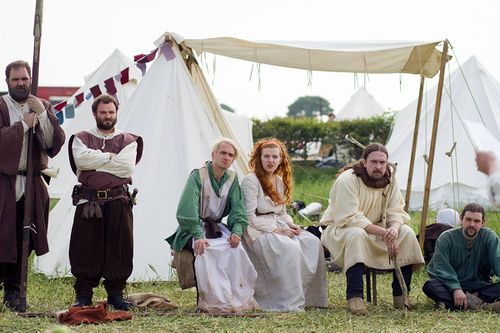
Whittle
A village in Freemoor, at the base of Whittle Hill, well known for its rich green iron mine. The inhabitants resisted the Jotun for thirty years - after an initial short-lived occupation by the Jotun they took back their village and the territory around it, dug in, and waited for help to come. Specifically, their survival hinged on an agreement with the local Jotun to let everything go to a fight-to-the-death between forces yearly rather than just be crushed. The Jotun agreed to this arrangement thinking they'd surely not hold on for more than a season or two. Instead, they held out for thirty years. In time, facing the Whittle folk in battle became a rite of passage for young Jotun in the Mournwold.
Unable to contact the outside world, lacking magical or mundane means to get word out that they were alive, they waited. While initially welcomed by their fellow Marchers when contact was re-established in Spring 380YE, it soon became clear that they had embraced the malign spiritual power of hatred - a power that they claimed gave them the will and the strength to resist the orcs and which they offered to share with the rest of the Marches. The Marcher assembly categorically refused their offer, encouraging the rest of the Marches to shun them.
When the Jotun reconquered Freemoor, the majority of the population moved to Tassato where they built a small enclave with the assistance of the city's Chamber of Commerce. Many Whittle folk died during the fall of Overton, fighting the Jotun in defence of the Mourn- a fact that has endeared them to many of the remaining Mournwolders. After the territory was liberated, they returned to their homes, but proved to be intractable opponents of the Mournwold thralls. In the end, after accusations of blasphemy and heresy in the Imperial Synod, the militia were sent in to apprehend the ringleaders. The Whittle folk refused to surrender their community leaders, and the siege ended in a bloodbath. Today Whittle is little more than a ghost town, and perhaps a cautionary tale about the danger caused by those who embrace the tenets of Hatred.
OOC Note: It is not possible to play a character who was from Whittle.
Regions
Alderly
- Quality: Forest
A forest of old oak and sycamore. Marcher faerie tales spoke of diminutive creatures who hide beneath the trees and prey on unruly children - references to a hidden Feni enclave deep in the woods. The Feni of Alderly occasionally raided into Green March, Chalkdowns, and Golden Downs, but for the most part they kept to themselves. The Marchers who lived in the forest were always considered peculiar, and three decades of isolation under the orcs just intensified their strangeness. Insular and uncommunicative, the hamlets and small villages of charcoal burners and woodcutters are known to have more than a little Feni blood, and there is some question whether the Alderly folk were even truly Marchers anymore. Regardless, however, they were still Mournwolders.
During the Jotun occupation, the deep woods were conquered only in theory - the Jotun controlled the grasslands beyond the forest, and the edges of the woodlands, but they did not go too deep. Likewise, when the Empire liberated the region in 381YE, they faced opposition from the Feni and settled for driving the Jotun out and claiming the lighter woodlands and the fields, rather than risk pushing too far into dangerous territory in the deeper woods. In the Winter of 382YE, however, the Drakes went into the deepwoods of Alderly and drove out the Feni. Many died; some fled to Liathaven; others apparently took darker paths. To the surprise of few, a number of the Marchers in the woods fought alongside the Feni; today the woods are mostly deserted save for a very few scattered, isolated hamlets who shun outsiders even more fiercely.
Chalkdowns
A land of rolling chalk downland with close-cropped turf and dry valleys, the people of the Chalkdowns are perhaps the closest to what an outsider thinks of when they imagine Marchers. They have their own peculiarities, however. The yeomen practice a particularly Mourn form of agriculture, combining raising corn and raising sheep, whose droppings help to fertilise the cornfields when they are not grazing on the springy Mournwold turf.
Due to their emphasis on farming, the yeomen of the Chalkdowns had a somewhat disproportionate level of influence over the Mournwold, and involvement in the politics of the Marches and the Empire alike. Perhaps as many as half of all senators for the Mournwold were picked by stewards from Chalkdowns in the years that the Mournwold was part of the Empire. This made the Chalkdowns prosperous, and the yeomanry wealthy, but it also led to a simmering resentment from the miners of Ore Hills and Southmoor. During the Jotun occupation the taxes claimed by their orc overlords impoverished even the richest, most stubborn farmers. With the Imperial liberation, it is likely that some of the yeomen who fled north (or their children) will want to return. What they will make of their new neighbours - orcs, and human thralls who endured the Jotun occupation - remains to be seen.
Freemoor
The wildest part of the Mournwold, Freemoor is split roughly between scrubby farmland in the west and wooded valleys in the east. The folk here had a reputation for being stand-offish on par with the people of Bregasland, especially those who preferred the gentle hills and woodlands of the west. Most of the farms here were never especially wealthy, but the stewards and yeomen were renowned for their stubborn refusal to go anywhere else. More Freemoor people than any other part of the Mournwold refused to leave when the Jotun came, and remained as thralls - albeit bitter, stubborn, intractable thralls.
There are three well-known landmarks in Freemoor: Old Pig, an aptly named chalk figure carved into the hills of the wold; the fortification of Landskeeper's Bulwark and The Whittle Hill, the largest hillock in the western Mournwold. The village of Whittle stands at the base of Whittle Hill, although most of its residents now live in Tassato Mestra.
Green March
Green March was always a little odd - isolated from the rest of the Mournwold by Alderly, the yeomanry often felt they had more in common with the farmers of Mitwold than their distant neighbours in Chalkdowns and Southmoor. The first region of Mournwold to fall to the Jotun, the site of the first engagement between the Imperial armies and the Jotun is still marked by a series of Jotun burial mounds that surround the ruins of the village of Kineton - half of them containing the bodies of soldiers who fell in a futile attempt to slow the orc advance.
Many of the citizens of Green March fled north to the Golden Downs; unlike many of the Mournwold refugees the majority of them show little interest in returning to reclaim the land they lost three decades ago.
Near the border with Bregasland stands an odd monument called High Courage. Looking down across the moors towards Liathaven, it is a large statue of a stag with broken antlers, ascribed to the people of Terunael. On a stone block at the base of the statue Imperial letters simply read “High Courage” but it is clear that they are more recent than the statue itself.
Greensward
- Qualities: Memorial, Ruins
The Greensward was the last holdout of Imperial presence in the Mourn. The refugees and survivors who set up camp at Overton are gone along with the town, the offices of the Sheriff of Overton, and the castle of Orchard's Watch. Greensward Monastery, the abbey that once served to keep the morale of the defenders high, is now a burnt out shell amid the foothills of Kahraman. The soil itself is said to have become sodden with the sheer amount of human and orc blood shed during the battles over the grasslands. Tens of thousands of humans and orcs died fighting in the Greensward, and these deaths have soured the earth here.
Overlooked by Farstriders Watch, the fields of the Greensward - the same fields that once made the stewards here rich from sales to Tassato in the east - are largely fallow. The yeofolk who might have worked them fled south to Kahraman, or east to Tassato. Others chose to go west with the Jotun, turning their backs on the Empire forever. The humans who remain are primarily monks and friars, tending to the dead, and seeking to offer some comfort to the ghosts that now haunt the Greensward.
Ore Hills
- Quality: Hills
The ore hills (sometimes rendered, unsurprisingly, as "our hills" in the drawling dialect favoured by the natives) are riddled with mine workings and quarries. The hills throughout the territory are rich in veins of green iron, but the Ore Hills are site of some of the most prosperous mines in the Mourn - as befits the legendary birthplace of Marcher folk hero Jonah Gold. Before the Jotun came, Ore Hills was the centre of dissatisfaction with the political realities of life in the Marches. In 326YE a poor harvest finally ignited the long drawn out conflict between the miners and the Chalkdowns farmers. In late Autumn a violent mob descended on the lowland farms and raided cattle and grain in a manner reminiscent of a Feni attack. The magistrates were quick to respond, arresting the ringleaders and in some cases executing the worst of them. The people of the Ore Hills still sing sad songs about this great "injustice" - much to the chagrin of the farmers of Chalkdowns and Freemoor. Further details are contained in The Ore Hills Rebellion, a historical research report published after the Spring Equinox 386YE.
Some of the older mines here have a bad reputation, and feature regularly in Marcher ghost-stories and cautionary tales. According to these stories unnatural things are occasionally sighted in the deepest parts of the oldest mines. Details are never clear and many sensible people dismiss them as either fantasy brought on by too much time without sunlight, or else ascribe the sightings to trogoni or perhaps even the ghost of old Jonah Gold.
Southmoor
- Quality: Hills
The last region to fall to the Jotun during their invasion, Southmoor is the location of Sarcombe, a prosperous mining town, rich off the back of trade in green iron to the Navarr in Liathaven, ruined during the last months of the orc invasion. The Jotun built a castle over the ruins - Hillstop - and it served as their main base of operations for their occupation of the Mournwold until the Autumn Equinox 381YE. The Jotun used it to keep a careful eye eastward to the Greensward - and beyond to Tassato. Jarl Haakon, a young but powerful Jotun leader, ruled much of the land in Southmoor. He was notorious for his hatred of the Feni - he led his warband into Alderly forest on three separate occasions, seeking to find and crush the heart of Feni power, but was never successful. He was considered a wise and just ruler by the standards of his own people; someone who ruled without favour or prejudice and was considered to have a promising future. He was forced to flee when the Mournwold fell, leaving his estates and his thralls behind, a failure that has by all accounts gnawed at him ever since.
The people of Southmoor before the invasion were considered more pragmatic than their neighbours in Ore Hills, at least as far as politics went. Sarcombe was a rich market town, and the alders made little secret of the fact that they used their wealth to influence the politics of the Mournwold when they felt the need. As such there was residual bad blood between the miners in the east, and those in the west, that was occasionally exploited by the senators of the Mourn. Today, the rich alders are gone. Indeed, most of the remaining residents appear to be orc thralls with the human residents long since fled or displaced.
During Summer 385YE, Jarl Haakon returned to Southmoor along with a small warband. The Jotun were apparently establishing hidden stores of food, caches of weapons, and makeshift palisades ready for when the armies of the Jotun once again invaded the Mourn. The Bailiff of the Downs led a contingent of Imperial heroes to confront the Jarl, but he and most of his band managed to escape. The location of the caches is unknown, despite the best efforts of the local beaters. A year later, the majority of the caches were removed by the beaters of the Marches along with support from the unconquered of Highguard.
| Summit | Elected |
|---|---|
| Spring Equinox 387YE | Simon "Chordwangler" Willow |
| Spring Equinox 386YE | Simon "Chordwangler" Willow |
| Spring Equinox 385YE | Willum of Goatsbridge |
| Spring Equinox 384YE | Alan Sheppard |
| Spring Equinox 383YE | Alan Sheppard |
| Spring Equinox 382YE | Robert Dunlain |
| Autumn Equinox 381YE | Robert Dunlain |
Recent Senate Elections
As an Imperial territory, Mournwold is represented by a senator elected in the Spring. This title is currently held by Simon "Chordwangler" Willow; it will be reelected at Spring Equinox 388YE. The table to the right shows the citizens who have been elected to hold this title in the years since Empress Britta died.
OOC Notes
- As of the start of the Autumn Equinox 387YE, the Marches controls the entire territory. The Mournwold is an Imperial territory.
- Unlike the rest of the Marches, the Mournwold does not currently benefit directly from the Imperial Breadbasket great work.
- Farstrider's Watch is a rank one fortification in Greensward.
- Landskeepers Bulwark is a rank one fortification in Freemoor.
- Businesses in the territory benefit from the Black Canal and produce an extra 36 rings each season
- Mines in the territory benefit from the Black Canal and produce an additional 4 ingots each season
- The campaign to first recapture the Mournwold is recounted in the Winds of War starting with Winter Solstice 379YE. There are also several Winds of Fortune detailing the problems following the liberation of the Mourn, including Watered with fears (Spring 381YE), All along the watchtower (Summer 381YE), and An apple that falls (Autumn 381YE).
Jonah Gold
Jonah Gold is a possibly-legendary figure whose story dates from the time of the Cousins' War. Jonah is said to to have been born in the Ore Hills long before the Mournwold was part of the Marches proper; in some versions he is the son of a Tassatan immigrant and a Marcher sheep herder. Stories say that Jonah was a miner who quarried out metal of such quality that his weapons turned the tide of war for his household during the short-lived Marcher civil war. A jealous friend betrayed him to the enemy, and for a heavy purse of coin staged a mining accident that trapped him behind a rockfall where he presumably perished. Over the centuries, a number of legends and stories have been attributed to Jonah - if the man had participated in all the stories attributed to him he would have been so busy moving around the Marches, southern Wintermark. and northern Brass Coast he would never have had time to do any actual mining!
His stories do not end with his death. His ghost is said to haunt the mines of the Marches, especially the green iron mines of the Mournwold. Superstitious miners say that to see Jonah Gold presages disaster - whether his appearance causes a catastrophe reminiscent of the collapse that killed him, or if he simply warns against them varies from legend to legend and place to place. There are even a few stories of sightings of what sounds a lot like Jonah Gold in the hills of Kahraman, and the old mines north of Tassato.
Some scholars who have taken the time to study the stories of his ghostly appearance disagree with the accepted wisdom that Jonah Gold is a ghost. While there is plenty of precedence for so-called "warning ghosts", these scholars argue that the sightings are actually of an astronomantic tulpa rather than a restless spirit - but their argument is undermined by an inability to agree on which constellation the tulpa represents.
Jonah's name has also been given to a variety of apple commonly grown in the Mournwold. Heavy, green and sweet, with a sharp bite, the "Jonah Gold" variety is used extensively in cooking sweet pies and apple sauce, and traditionally is buried with miners from the Mourn, particularly those who quarry green iron.
His story is immortalised in the popular song that bears his name.